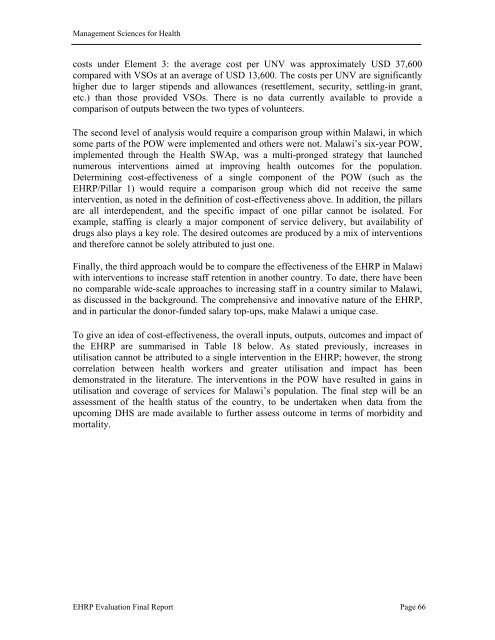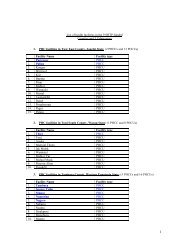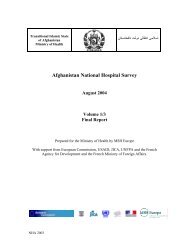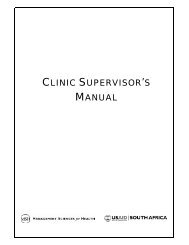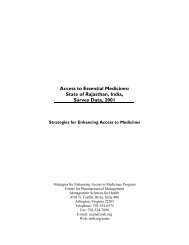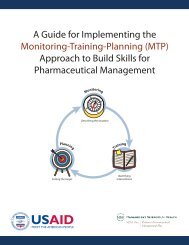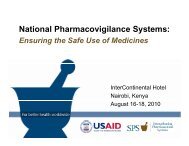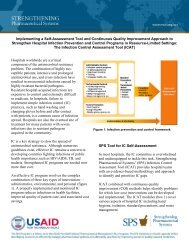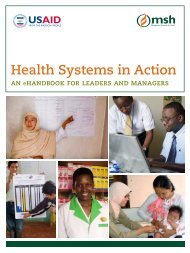Evaluation of Malawi's Emergency Human Resources Programme
Evaluation of Malawi's Emergency Human Resources Programme
Evaluation of Malawi's Emergency Human Resources Programme
You also want an ePaper? Increase the reach of your titles
YUMPU automatically turns print PDFs into web optimized ePapers that Google loves.
Management Sciences for Health<br />
costs under Element 3: the average cost per UNV was approximately USD 37,600<br />
compared with VSOs at an average <strong>of</strong> USD 13,600. The costs per UNV are significantly<br />
higher due to larger stipends and allowances (resettlement, security, settling-in grant,<br />
etc.) than those provided VSOs. There is no data currently available to provide a<br />
comparison <strong>of</strong> outputs between the two types <strong>of</strong> volunteers.<br />
The second level <strong>of</strong> analysis would require a comparison group within Malawi, in which<br />
some parts <strong>of</strong> the POW were implemented and others were not. Malawi’s six-year POW,<br />
implemented through the Health SWAp, was a multi-pronged strategy that launched<br />
numerous interventions aimed at improving health outcomes for the population.<br />
Determining cost-effectiveness <strong>of</strong> a single component <strong>of</strong> the POW (such as the<br />
EHRP/Pillar 1) would require a comparison group which did not receive the same<br />
intervention, as noted in the definition <strong>of</strong> cost-effectiveness above. In addition, the pillars<br />
are all interdependent, and the specific impact <strong>of</strong> one pillar cannot be isolated. For<br />
example, staffing is clearly a major component <strong>of</strong> service delivery, but availability <strong>of</strong><br />
drugs also plays a key role. The desired outcomes are produced by a mix <strong>of</strong> interventions<br />
and therefore cannot be solely attributed to just one.<br />
Finally, the third approach would be to compare the effectiveness <strong>of</strong> the EHRP in Malawi<br />
with interventions to increase staff retention in another country. To date, there have been<br />
no comparable wide-scale approaches to increasing staff in a country similar to Malawi,<br />
as discussed in the background. The comprehensive and innovative nature <strong>of</strong> the EHRP,<br />
and in particular the donor-funded salary top-ups, make Malawi a unique case.<br />
To give an idea <strong>of</strong> cost-effectiveness, the overall inputs, outputs, outcomes and impact <strong>of</strong><br />
the EHRP are summarised in Table 18 below. As stated previously, increases in<br />
utilisation cannot be attributed to a single intervention in the EHRP; however, the strong<br />
correlation between health workers and greater utilisation and impact has been<br />
demonstrated in the literature. The interventions in the POW have resulted in gains in<br />
utilisation and coverage <strong>of</strong> services for Malawi’s population. The final step will be an<br />
assessment <strong>of</strong> the health status <strong>of</strong> the country, to be undertaken when data from the<br />
upcoming DHS are made available to further assess outcome in terms <strong>of</strong> morbidity and<br />
mortality.<br />
EHRP <strong>Evaluation</strong> Final Report Page 66


